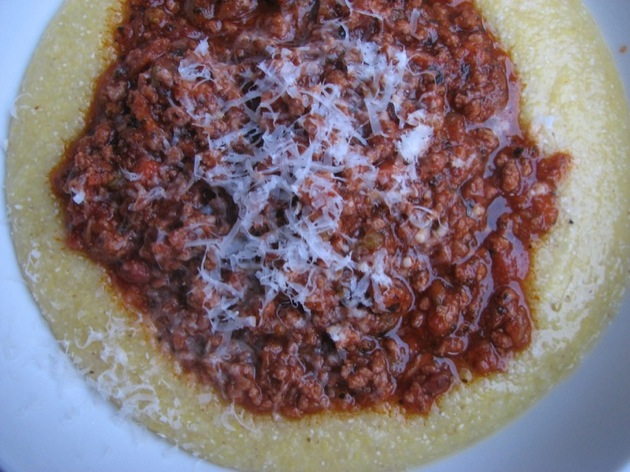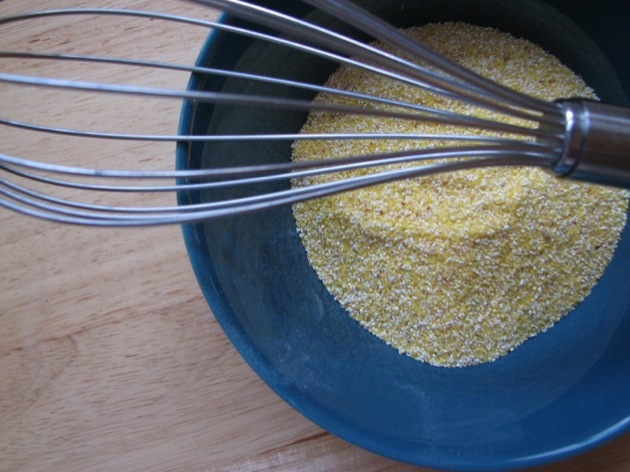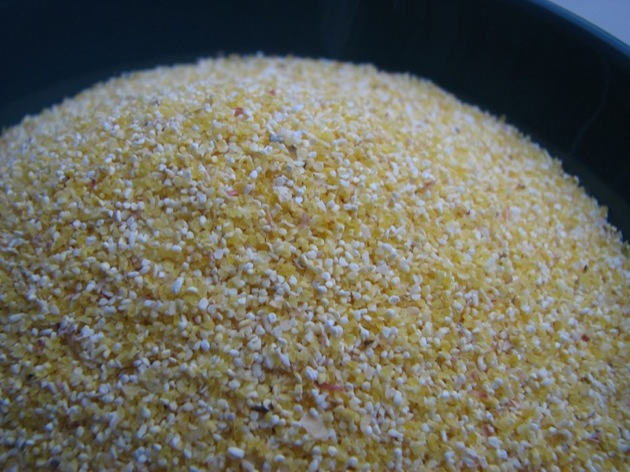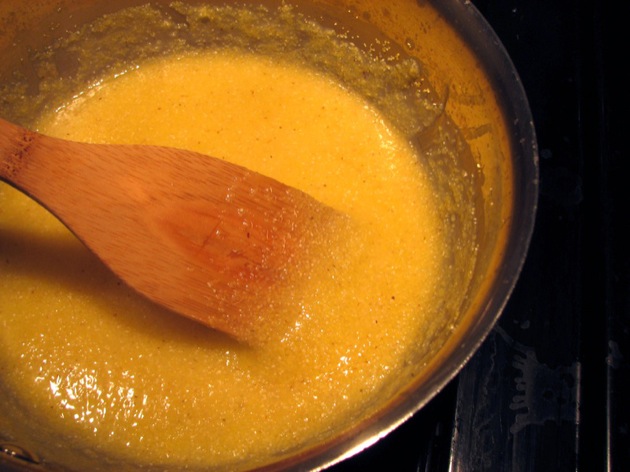Polenta, Where Have You Been All My Life?
Polenta is only water, salt, and cornmeal, unless a cook chooses, in the style of risotto, to finish with a knob of butter or a hill of Parmesan cheese. It is one those dishes so simple, its execution can be lackluster or transcendent, depending on who makes it. What happens when these three things are combined is anyone's guess. The result can be like cornbread blended with water, a soupy, leaden porridge--or it can be silky, the essence of cornness, "each grain swollen from the slow simmering and yet still rough, even gravelly, against the roof of the mouth." That was Bill Buford describing his first experience of true polenta at a restaurant in Italy, which sent him headlong into an obsessive quest to learn to cook it properly, in his book Heat . Good polenta can be a revelation.
While I was reading Saveur 's excellent article about the history and arguments over proper Bolognese sauce in Italy (not online), I came across some passages about how Bolognese is sometimes served not over freshly-made pasta, but on a bed of wet polenta instead. I was doing the reading of this article on the way home from work on the subway, which also coincides with the general timeframe when my lunch has finished digesting. Usually this happens just after the doors ding shut--the hunger pangs--and I know that I have 40 more minutes of standing around dizzily in a jolting, delayed, packed train before I'll have a chance to eat anything again.
There I was reading about giant bowls of creamy polenta topped with deep, rich, meaty bolognese sauce, when I remembered, A-HA! , buried in the back of the freezer, was a big plastic tub of deep, rich, meaty bolognese sauce that we cooked a few months ago for a lasagne . I also took inventory and remembered a bag of organic stone-ground coarse cornmeal that we picked up at the Sheep and Wool Festival last year (not that that's a particularly obvious connection, wool + cornmeal, but nevertheless). I decided immediately what would we eaten for dinner, and this thought carried me all the way home, into the kitchen, and in front of a simmering pot of future polenta.
Polenta should be nothing like Cream of Wheat. This isn't instant combine-with-boiling-water-and-serve; true polenta is a transformation of ground kernels of dried corn swelled in water, until a distinctly grainy-yet-smooth soup emerges. It can be served thus, "wet," or it can be cooked further until stiff and cake-like, sometimes spread out to dry and sliced and fried.
I have no idea how to cook polenta.
The first wisdom, as with risotto, another slow-cooking grain-based dish, is to stir constantly . The first time Nick and I cooked risotto , this admonishment to stir consumed us; it was all we could think about. Must keep stirring or else the whole dish will stick to itself and emerge gluey, some of the rice mushy and the rest of it half-cooked and chalky. Experienced cookbook authors warned that the rice would give up its starch too early if the heat was too high--or maybe it was the other way around?
It turns out that the risotto rumor has been greatly exaggerated. Mario Batali declared on Mark Bittman's PBS show " Best Recipes in the World " last year that stirring risotto regularly was kind of a myth: you should stir when you add some more liquid, maybe once or twice between then, but otherwise just leave it on low heat and let the rice trade its starch for stock. It's true: I watched him make it on-camera, and though I didn't taste this televised Laid-Back Risotto , it looked perfectly delicious; and Bittman declared it so, which, considering the friendly competition that he and Batali tend to have on the show, was probably true.
So what does this mean for polenta? It turns out Bill Buford's quest yielded similar epiphanies: apparently the rumor applies here, too. There is a certain amount of stirring that must be done at the start of polenta, when the cornmeal is first added; but after that, not much at all. It can be left to sit, bubbling like a cauldron, stirred occasionally when one happens by the stove.
Cornmeal and water can be cooked a number of ways. The French of the northern Alps cook their polenta" like cous cous, baking it in the oven with stock until the liquid is absorbed, followed by a fluff. grits , in the Deep South tradition, uses corn treated with an alkali solution that removes the hull of each kernel, which are then dried and ground and cooked similarly to polenta, with liquid over low heat. Masa Harina , which ends up as corn tortillas, is also made from corn treated in this manner, but it is ground much more finely into flour.
Nevertheless, there is something profound about the simplicity of stone-ground untreated cornmeal, water, salt--the basis of Italian polenta. With a few books in hand -- Mark Bittman , of course, and also Jamie Oliver , Madeleine Kamman , and Bill Buford's recipe-less but ecstatic prose description -- I set out to make my first bowl of the stuff.
It met my expectations so fully and profoundly that I could hardly believe it. This was a huge bowl of complete comfort food, smooth, rich, flavorful. Maybe it was the quality of the cornmeal, or the fact that I cheated and put butter and Parmesan in at the end. But I was so surprised at how delicious this was, I feel like I need to visit Italy to taste how much even better it can be. Could making polenta really be as easy as I found it to be?
The recipe that I eventually used, from Mark Bittman's How to Cook Everything , is introduced with the following line: "Making good polenta is fairly easy; see Basic Polenta, below. Making exceptional polenta takes more time, patience, and stirring, but it isn't difficult, either." It seems I made merely good polenta, which, for now, was a revelation in itself. Exceptional polenta can only be in my future.
Mark Bittman's Basic Polenta
- 4 1/2 cups water
- 1 teaspoon salt, plus more if necessary
- 1 cup medium-grind stone-ground cornmeal, highest quality possible
- Freshly ground black pepper to taste
- 2 tablespoons butter (optional)
- 1/4 cup freshly grated Parmesan cheese
- Bolognese sauce, or some snipped herbs, or a fried egg...
Makes 4 servings
Bring water to boil in a small saucepan, salt it, then turn the heat to medium. Whisking constantly, add the cornmeal a little at a time until it's all incorporated. Turn the heat to low.
For the first five minutes, whisk often to avoid any lumps. Then switch to a flat-bottomed wooden spoon, stirring often until the water is absorbed.
A little boiling water from a kettle is nice to have on hand in case it gets too dry and the cornmeal is not cooked. Wet polenta should take about 15-20 minutes; dry polenta will begin to pull away from the sides of the pan and can take as long as 40 minutes. Salt and pepper liberally, to taste.
Stir in the optional butter and cheese, remove from heat, and serve with accompaniments.
Bill Buford, Bolognese, Corn, Polenta, Uncategorized





Comments:
Blog Comments powered by Disqus.